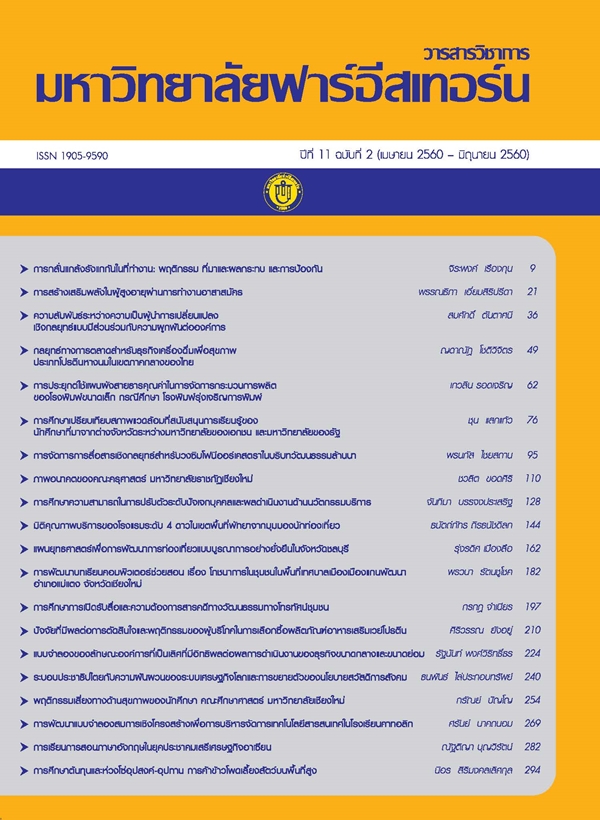ความสัมพันธ์ระหว่างความเป็นผู้นำการเปลี่ยนแปลงเชิงกลยุทธ์ แบบมีส่วนร่วมกับความผูกพันต่อองค์การตามการรับรู้ ของบุคลากรโรงงานผลิตอาหารสัตว์นํ้ามหาชัย ในเครือบริษัทเจริญโภคภัณฑ์อาหาร จำกัด (มหาชน)
Main Article Content
Abstract
การวิจัยนี้มีวัตถุประสงค์เพื่อศึกษา 1) การรับรู้เกี่ยวกับความเป็นผู้นำการเปลี่ยนแปลงเชิงกลยุทธ์
แบบการมีส่วนร่วม 2) การรับรู้เกี่ยวกับความผูกพันต่อองค์การ 3) ความสัมพันธ์ระหว่างการรับรู้เกี่ยวกับ
ความเปน็ ผูน้ ำการเปลี่ยนแปลงเชิงกลยุทธแ์ บบมีสว่ นรว่ มกับความผูกพันตอ่ องคก์ ารของบุคลากรโรงงานผลิต
อาหารสัตว์นํ้ามหาชัยในเครือบริษัทเจริญโภคภัณฑ์อาหาร จำกัด (มหาชน) ใช้การวิจัยเชิงปริมาณ
โดยการสำรวจ เครื่องมือ คือ แบบสอบถาม คำนวณจำนวนตัวอย่างด้วยสูตรของ Yamane ได้ 265 คน
ผูวิ้จัยแจกแบบสอบถาม 300 ชุด ไดรั้บกลับคืน 288 ชุด จึงใชตั้วอยา่ ง 288 คน โดยสุม่ ตัวอยา่ งแบบเปน็ ระบบ
วิเคราะห์การรับรู้ของบุคลากรเกี่ยวกับความเป็นผู้นำการเปลี่ยนแปลงเชิงกลยุทธ์แบบมีส่วนร่วม และ
ความผูกพันต่อองค์การโดยใช้ค่าเฉลี่ย และส่วนเบี่ยงเบนมาตรฐาน หาค่าความสัมพันธ์ของการรับรู้
ของบุคลากรเกี่ยวกับความเปน็ ผูน้ ำการเปลี่ยนแปลงเชิงกลยุทธแ์ บบการมีสว่ นรว่ มกับความผูกพันตอ่ องคก์ าร
และทดสอบสมมติฐานโดยใช้ค่าสัมประสิทธิ์สหสัมพันธ์สเปียร์แมนแรงค์ ที่ระดับนัยสำคัญทางสถิติ .05
ผลการวิจัยพบวา่ การรับรูข้ องบุคลากรเกี่ยวกับ 1) ความเปน็ ผูน้ ำการเปลี่ยนแปลงเชิงกลยุทธแ์ บบการมีสว่ นรว่ ม
(ค่าเฉลี่ย 3.50 ส่วนเบี่ยงเบนมาตรฐาน 0.88) และ 2) ความผูกพันต่อองค์การ (ค่าเฉลี่ย 3.71ส่วนเบี่ยงเบน
มาตรฐาน 0.88) อยูใ่ นระดับมาก 3) การรับรูข้ องบุคลากรเกี่ยวกับความเปน็ ผูน้ ำการเปลี่ยนแปลงเชิงกลยุทธ์
แบบการมีสว่ นรว่ มกับความผูกพันตอ่ องคก์ ารมีความสัมพันธเ์ ชิงบวกอยูใ่ นระดับสูงมาก (สัมประสิทธิ์ สหสัมพันธ์
.753, p-Value .000) มีนัยสำคัญทางสถิติระดับ .05 เป็นไปตามสมมติฐาน
The objectives of this research were to study 1) personnel’s perception of ParticipativeLeadership for Strategic Change 2) personnel’s perception of organizational commitment 3) the relationship between the personnel’s perception regarding Participative Leadership for Strategic Change coincidently with organizational commitment for The Aquaculture Feed Mill (Mahachai) in the group of Charoen Pokphand Foods PCL. Quantitative research by surveying was employed as research methodology and questionnaire was employed as research instrument. The number of samples calculated by the formula of Yamane (Yamane, 1967) were 265 samples, researchers distributed 300 questionnaires, and received 288 questionnaires. Thus, this research used 288 people for the samples. Sampling method used Systematic Sampling. Then analyzed data by Mean and Standard Deviation for personnel's perception regarding Participative Leadership for Strategic Change and organizational commitment. Finding out the relationship of personnel's perception regarding Participative Leadership for Strategic Change with organizational commitment and test the hypothesis by Spearman's Rank Correlation Coefficient. The statistical significance level was defined at .05. The research results found that 1) personnel’s perception of Participative Leadership for Strategic Change ( X = 3.50, S.D. = .88) and 2) personnel’s perception of organizational commitment ( X = 3.71, S.D. = .88) were at a high level. 3) the relationship between the personnel’s perception regarding Participative Leadership for Strategic Change coincidently with organizational commitment were positive direction at very high level (r = .753, p-Value =.000) at .05 level of significance. The research results proved research hypotheses.
Article Details
1. Any views and comments in the Journal of Social Innovation and Lifelong Learning are the authors’ views. The editorial staff have not to agree with those views and it is not considered as the editorial’s responsibility.
2. The responsibility of content and draft check of each article belongs to each author. In case, there is any lawsuit about copyright infringement. It is considered as the authors’ sole responsibility.
3. The article copyright belonging to the authors and The Far Eastern University are copyrighted legally. Republication must be received direct permission from the authors and The Far Eastern University in written form.
References
Books
Harvard Business Review Analytic Services. (2013). The Impact of Employee Engagement on Performance. NY: Harvard Business Publishing.
McClelland, D. C. (1961). The Achieving Society. Princeton, NJ: Van Nostrand.
Vance, R. J. (2006). Employee Engagement and Commitment; A Guide to Understanding, Measuring and Increasing Engagement in Your Organization. VA: SHRM Foundation.
Yamane, T. (1967). Statistics, An Introductory Analysis, 2nd Ed. NY: Harper and Row.
Articles
Buchanan, B. (1974). Building Organizational Commitment: The Socialization of Managers in Work Organizations. Administrative Science. Quarterly(19), 533 - 546.
Cronbach, L. J. (1951). Cronbach, L.J. Coefficient Alpha and the Internal Structure of Tests. Psychometrika, 16, 297 - 334. Psychometrika. 16(3), 297 - 334.
Denison, D., & Mishra, A. (1995). Toward a Theory of Organizational Culture and Effectiveness. Organization Science. 6(2), 204 - 223.
Fox, S., Spector, P., & Miles, D. (2001). Counterproductive Work Behavior (CWB) in Response to Job Stressors and Organizational Justice: Some Mediator and Moderator Tests for Autonomy and Emotions. Journal of Vocational Behavior. 59, 291 - 309.
Maslow, A. H. (1943). A Theory of Humsn Motivation. Psychological Review. 50, 370 - 396.
Mowday, R., Steers, R., & Porter, L. (1979). The Measurement of Organizational Commitment. Journal of Vocational Behavior. 14, 224 - 247.

